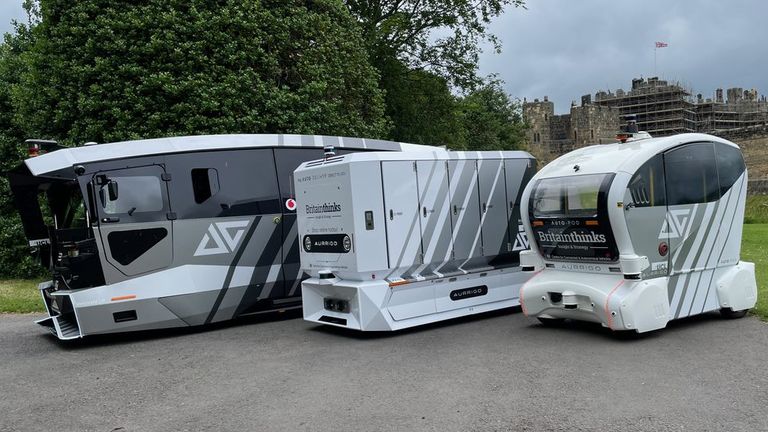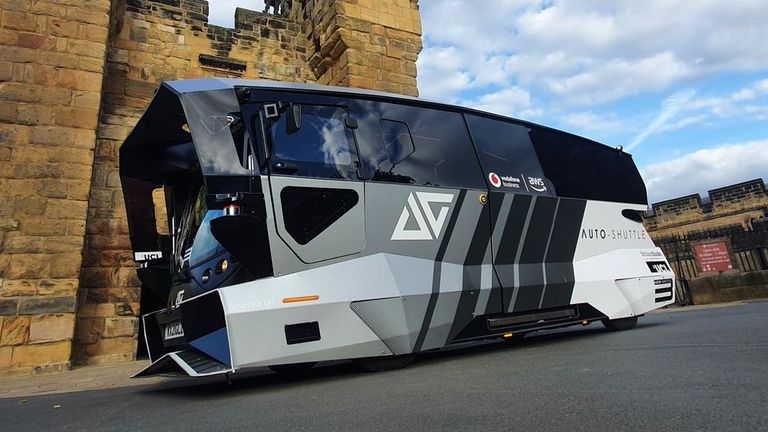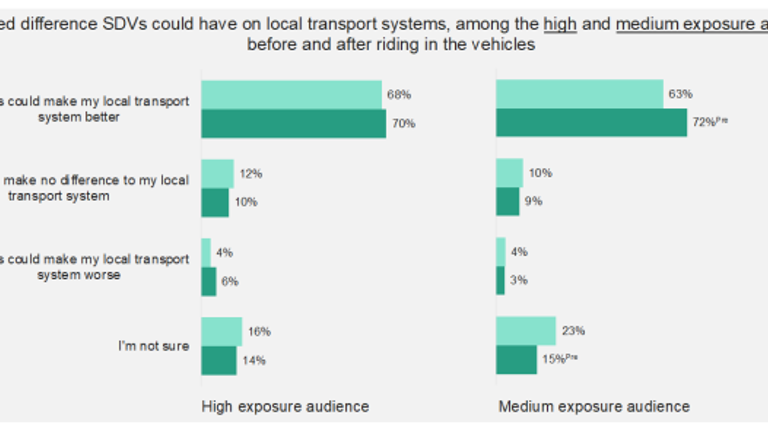Self-driving vehicles 'could bridge gaps in UK's public transport network'
A new report, led by the Department for Transport (DfT), involved trialling SDVs to ferry people around Alnwick in Northumberland, Manchester City's Etihad sports complex, and the town of Taunton in Somerset.
Friday 14 July 2023 14:22, UK
Self-driving vehicles could be used to bridge the gaps in the UK's public transport network, according to the results of a new government-led study.
The survey, the first of its kind in the country, found up to 72% of people believed the vehicles could be used to improve transport links - particularly in rural areas.
Better evening, night and weekend services, creating smaller and more direct services, and providing shuttle services between villages and railway stations, were among the suggestions put forward.
People taking part in the survey also said they believed self-driving vehicles (SDVs) could be used to cut congestion and boost the economy.
But the study also highlighted concerns among members of the public, with safety the most prominent issue, alongside the possibility of job losses, and the set-up costs for already cash-strapped councils.
Fully-automated SDVs are not currently legal on UK roads, despite some vehicles, such as Teslas, already having the technology built into their cars.
The government is currently reviewing SDV technology, and a legal framework for its use on UK roads is expected to be in place by 2025.
The study, led by the Department for Transport (DfT), involved trialling SDVs in three locations - a rural area, a town and a city - to gauge public reaction to the technology.
As part of the trial, an Aurrigo Auto-Shuttle was used to ferry people around Alnwick in Northumberland, Manchester City's Etihad sports complex in Manchester, and the town of Taunton in Somerset.
An Aurrigo Auto-pod was used for a similar exercise - on private roads - around Alnwick Castle and the walkway to Manchester City's football ground.
Meanwhile, researchers exposed three different groups to low, medium and high levels of information about SDVs, and held a separate national survey as a control.
Nearly a quarter (24%) of people who took part in a national survey said they believed the vehicles could improve public transport links, according to the report.
Read more:
Passengers travel on self-driving bus for first time in UK
Will 'virtual eyes' help us to trust driverless cars?
But it was as high as 63% in the medium information group, and 46% in the high exposure, both of whom were given trial rides on the vehicles.
The national survey, however, revealed the public still had significant doubts about the technology, particularly the use of fully-autonomous SDVs.
Nearly a third (32%) of those who took part said they felt uncomfortable using self-driving public transport, and a similar figure (36%) felt uncomfortable sharing the road with one.
A fifth (20%) said they believed SDVs could make public transport worse, while 14% believed it would make no difference.
Those who took part also raised issues over the loss of drivers and the loss of social interaction and the possibility of becoming stranded if the vehicles malfunction.
Some even said they worried about a move towards a "dystopian" future.
But the study showed that, after using the services, the mood towards SDVs improved significantly.
After riding the Auto-Shuttle, 72% of the medium exposure group said they felt SDVs could improve local transport links, compared to 63% before the ride.
Be the first to get Breaking News
Install the Sky News app for free


In January, passengers travelled on a full-size self-driving bus for the first time in the UK.
A group of 22 volunteers, part of a co-design panel, took a test journey on the autonomous single-decker over the Forth Road Bridge near Edinburgh, operator Stagecoach said.
It was part of the CAVForth project which said at the time that it aimed to have five self-driving buses run timetabled services from the spring.
In August last year, the UK government announced a £100m investment with the aim of getting fully self-driving vehicles on UK roads by 2025.
SDV technology relies on multiple cameras and range-detecting lasers to navigate and spot vehicles, pedestrians and other obstacles.
Supporters say it can make roads safer and cut driver error, but the testing and rules and regulations around the technology are still being worked out.










